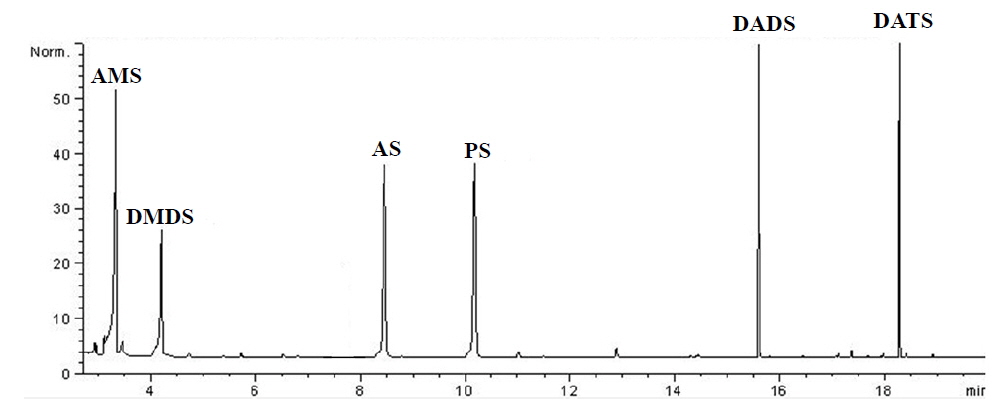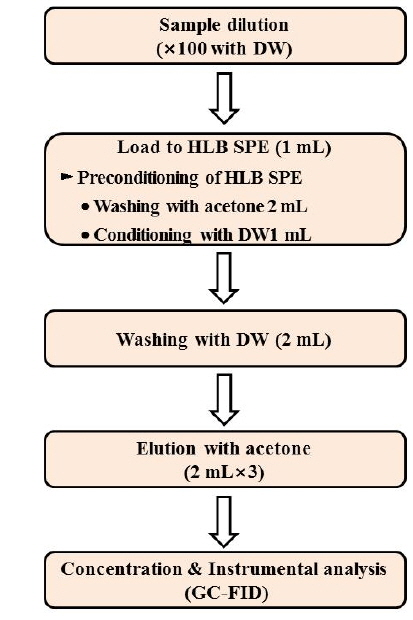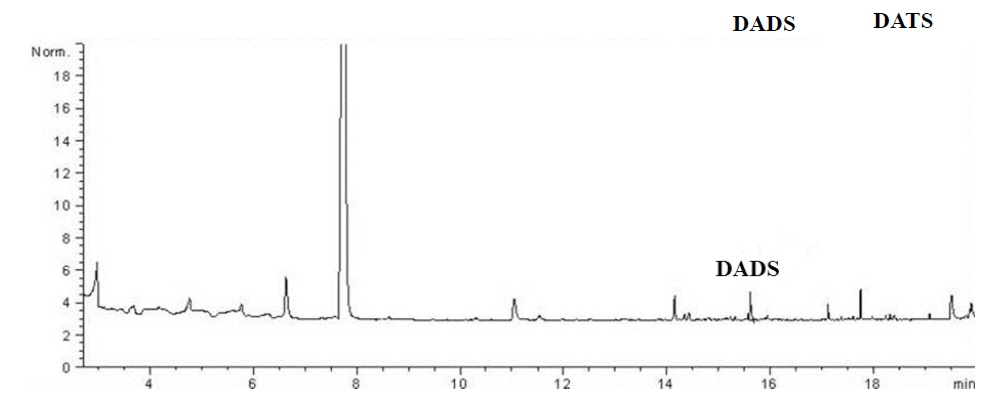



Garilc (
Alliin [
Recently, Lee
Alliin(99.5% purity), allicin(74.8% purity), allylmethyl sulfide(AMS, 94.3% purity), allyl sulfide(AS, 99.6% purity), dipropyl sulfide(DPS, 98.5% purity), dimethyl disulfide(DMDS, 99.4% purity), diallyl disulfide(DADS, 71% purity), and diallyl trisulfide(DATS, 95% purity) were purchased from CromaDex Irvine, California, USA. Acetone was obtained from Tedia, Ohio, USA. Analytical grade ethyl acetate, dichloromethane, ether, pentane, and hexane were purchased from Dae Jung Chemicals, Siheung, Korea. The anhydrous sodium sulfate, an analytical reagent grade was purchased from Merck India Ltd., Mumbai, India. ENVI-Carb solid phase extraction(SPE) cartridge(0.5 g, 6 mL, from Supelco, Philadelphia, USA) and hydrophilic and lipophilic balance(HLB) SPE cartridge(60 mg, 3 mL, from Waters, Milford, USA) were used for clean-up. Likewise, nine commercial biopesticides containing
>
Selection of marker compounds in biopesticides
In selecting the marker compounds in the biopesticides containing
>
Clean-up of marker compounds
To clean-up the marker compound in biopesticides containing
>
Gas chromatography(GC) analysis
GC conditions for analyzing DMDS, DADS, and DATS were: system, Agilent 6890 series with FID (Agilent, Santa Clara, USA); column, RTX-5(30 m×250 mm×250 mm, RESTEK, Pennsylvania, USA); carrier gas, He(99.999%, 3 mL min-1); inlet temperature, 230℃; column temperature, initial 40℃(8 min hold), 5℃ min-1, 60℃, 15℃ min-1, 230℃(hold 1 min); detector temperature, 300℃; and injection volume, 1 μL.
Sample preparation and analytical methods were validated in terms of linearity, limits of quantitation(LOQ), confirmatory, and precision. The linearity of the calibration curves in five replicates was injected at 0.5, 1, 2.5, 5, 10, and 25 mg L-1 concentrations, respectively. The LOQ for DMDS, DADS, and DATS were considered as the concentration that produced a signal-to-noise ratio of 10. Confirmatory of three replicates was determined through the recovery assay results of samples spiked with all analytes at 6 mg L-1. Recovery rates were calculated by comparing the concentrations of the extracted compounds with those from the DMDS, DADS, and DATS calibration curves, respectively. The intermediate precision, expressed as relative standard deviation(RSD, %), was determined in five replicates at different levels for three days.
>
Selection of marker compound
Eight sulfide substances, namely, alliin, allicin, AMS, DMDS, AS, PS, DADS, and DATS were studied as marker compounds in biopesticides containing
Liquid-liquid extraction and SPE cartridge were used in the clean-up of the biopesticide containing
ENVI-Carb and HLB SPE cartridges have been used in cleaning the marker compounds in commercial biopesticides(Lee
[Table 1.] Validation parameters

Validation parameters
Calibration curves of DMDS, DADS and DATS showed peak area of analytes standard at 0.5-25 mg L-1, respectively. The coefficient of correlation of all calibration curves was higher than 0.9998. The LOQs of DMDS, DADS and DATS were 0.202 mg L-1, 0.048 mg L-1 and 0.036 mg L-1, respectively(Table 1). Confirmatory test of the analytical method was determined based on the recovery rates of the spiked sample without
>
Substance levels in commercial biopesticides
The developed method for DMDS, DADS and DATS analysis was applied to commercial biopesticides containing

Contents of dimethyl disulfide(DMDS), diallyl disulfide(DADS), and diallyl trisulfide(DATS) in commercial biopesicides containing A. sativum extract
Recently, Pongsak and Parichat(2008) reported that the minimum inhibitory concentration(MIC) of DADS and DATS for antimicrobial activities were 8-24 mg L-1 and 2-12 mg L-1, respectively. Also, the DMDS lethal concentrations causing 50% mortality(LC50) in
The DADS excluding DMDS and DATS concentrations of the majority of commercial biopesticides studied was good for crop protection. However, commercial biopesticides were generally used after 100-1000 times dilution with water. If commercial biopesticides were practically scattered for crop protection, the DADS concentration should be lower than 100 times and lower than MIC for antimicrobial activity. Hence, the quality control of biopesticides should be conducted to determine their efficiency levels for crop protection.
Three from eight marker compounds in biopesticides containing





